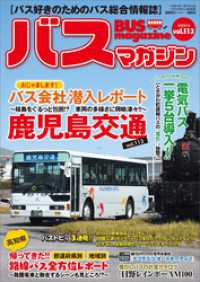- ホーム
- > 洋書
- > 英文書
- > Science / Mathematics
Full Description
The only book explaining modern MWD technology, to include hardware design, signal processing and telemetry, offering unique approaches to high-data-rate well logging Trade magazines and review articles describe MWD in casual terms, such as positive versus negative pulsers, continuous wave systems, drilling channel noise, and attenuation, often devoid of technical rigor. However, few truly scientific discussions are available on existing methods, let alone the advances necessary for high-data-rate telemetry. Without a strong foundation building on solid acoustic principles, rigorous mathematics, and of course, fast, inexpensive and efficient testing of mechanical designs, low data rates will impose unacceptable quality issues to real-time formation evaluation for years to come. This book promises to change all of this. The lead author and M.I.T. educated scientist, Wilson Chin, and Yinao Su, academician, Chinese Academy of Engineering, and other team members have written the only book available that develops mud pulse telemetry from first principles, adapting sound acoustic principles to rigorous signal processing and efficient wind tunnel testing.In fact, the methods and telemetry principles developed in the book were recently adopted by one of the world s largest industrial corporations in its mission to redefine the face of MWD. The entire engineering history for continuous wave telemetry is covered anecdotal stories and their fallacies, original hardware problems and their solutions, different noise mechanisms and their signal processing solutions, apparent paradoxes encountered in field tests and simple explanations to complicated questions, and so on, are discussed in complete tell all detail for students, research professors, and professional engineers alike. These include signal processing algorithms, signal enhancement methods, and highly efficient short and long wind tunnel test methods, whose results can be dynamically re-scaled to real muds flowing at any speed. A must-read for all petroleum engineering professionals!Inside this groundbreaking new volume, readers will find: * An explanation of mud pulse technology clearly using scientific principles ideas showing limitations of present systems and how they can be overcome * Innovative methods for signal enhancements needed for very deep wells constructive wave interference, sirens in series, special adaptations of frequency-shift-keying, and others * A blueprint for high-data-rate mud pulse telemetry adopted by several of the world s top energy corporations, explained in simple-to-understand terms, from first principles and rigorous physics to advanced mathematical concepts for signal processing, noise removal and echo cancellation * New wind short and long tunnel designs and test methodologies for mud sirens and turbines from Wilson Chin, the originator of wind tunnel modeling for downhole applications
Contents
Opening Message xiii Preface xv Acknowledgements xix 1 Stories from the Field, Fundamental Questions and Solutions 1 1.1 Mysteries, Clues and Possibilities 1 1.2 Paper No. AADE-11-NTCE-74, High-Data-Rate Measurement-While-Drilling System for Very Deep Wells, updated 10 1.3 References 46 2 Harmonic Analysis: Six-Segment Downhole Acoustic Waveguide 47 2.1 MWD Fundamentals 48 2.2 MWD Telemetry Concepts Re-examined 49 2.3 Downhole Wave Propagation Subtleties 58 2.4 Six-Segment Downhole Waveguide Model 62 2.5 An Example: Optimizing Pulser Signal Strength 77 2.6 Additional Engineering Conclusions 83 2.7 References 85 3 Harmonic Analysis: Elementary Pipe and Collar Models 86 3.1 Constant area drillpipe wave models 86 3.2 Variable area collar-pipe wave models 92 3.3 References 96 4 Transient Constant Area Surface and Downhole Wave Models 97 4.1 Method 4-1. Upgoing wave reflection at solid boundary, single transducer deconvolution using delay equation, no mud pump noise 99 4.2 Method 4-2. Upgoing wave reflection at solid boundary, single transducer deconvolution using delay equation, with mud pump noise 108 4.3 Method 4-3. Directional filtering - difference equation method requiring two transducers 112 4.4 Method 4-4. Directional filtering - differential equation method requiring two transducers 120 4.5 Method 4-5. Downhole reflection and deconvolution at the bit, waves created by MWD dipole source, bit assumed as perfect solid reflector 126 4.6 Method 4-6. Downhole reflection and deconvolution at the bit, waves created by MWD dipole source, bit assumed as perfect open end or zero acoustic pressure reflector 133 4.7 References 139 5 Transient Variable Area Downhole Inverse Models 140 5.1 Method 5-1. Problems with acoustic impedance mismatch due to collar-drillpipe area discontinuity, with drillbit assumed as open-end reflector 142 5.2 Method 5-2. Problems with collar-drillpipe area discontinuity, with drillbit assumed as closed end, solid drillbit reflector 150 5.3 References 152 6 Signal Processor Design and Additional Noise Models 153 6.1 Desurger Distortion 154 6.2 Downhole Drilling Noise 160 6.3 Attenuation Mechanisms 164 6.4 Drillpipe Attenuation and Mudpump Reflection 167 6.5 Applications to Negative Pulser Design in Fluid Flows and to Elastic Wave Telemetry Analysis in Drillpipe Systems 170 6.6 LMS Adaptive and Savitzky-Golay Smoothing Filters 172 6.7 Low Pass Butterworth, Low Pass FFT and Notch Filters 174 6.8 Typical Frequency Spectra and MWD Signal Strength Properties 175 6.9 References 176 7 Mud Siren Torque and Erosion Analysis 177 7.1 The Physical Problem 177 7.2 Mathematical Approach 183 7.3 Mud Siren Formulation 188 7.4 Typical Computed Results and Practical Applications 198 7.5 Conclusions 204 7.6 References 205 8 Downhole Turbine Design and Short Wind Tunnel Testing 206 8.1 Turbine Design Issues 206 8.2 Why Wind Tunnels Work 208 8.3 Turbine Model Development 211 8.4 Software Reference 215 8.5 Erosion and Power Evaluation 219 8.6 Simplified Testing 221 8.7 References 223 9 Siren Design and Evaluation in Mud Flow Loops and Wind Tunnels 224 9.1 Early Wind Tunnel and Modern Test Facilities 225 9.2 Short wind tunnel design 236 9.3 Intermediate Wind Tunnel for Signal Strength Measurement 248 9.4 Long Wind Tunnel for Telemetry Modeling 259 9.5 Water and Mud Flow Loop Testing 264 10 Advanced System Summary and Modern MWD Developments 273 10.1 Overall Telemetry Summary 274 10.2 MWD Signal Processing Research in China 291 10.3 MWD Sensor Developments in China 300 10.4 Turbines, Batteries and Closing Remarks 337 10.5 References 341 Cumulative References 342 Index 347 About the Authors 354

![【分冊版】初級日本語よみもの げんき多読ブックス Box 3: L16-2 彦一の話 [Separate Volume] GENK](../images/goods/ar2/web/eimgdata/EK-1488994.jpg)






